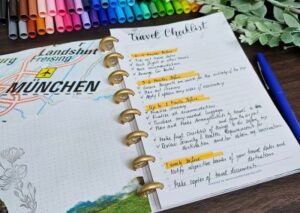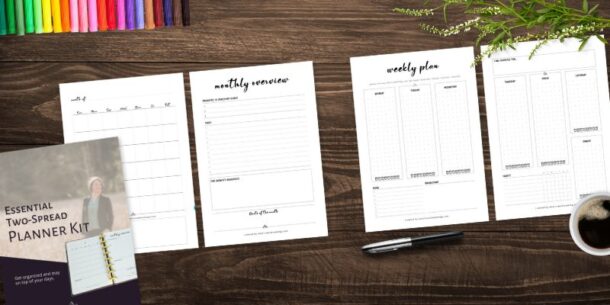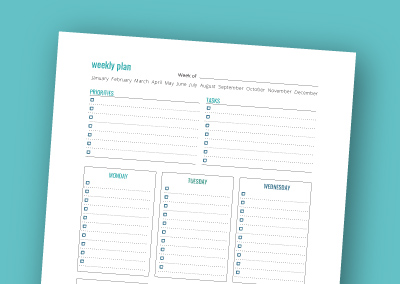
by Nikola | Sep 21, 2023 | An Organized Life
In today’s fast-paced world, finding effective ways to manage our time, set goals, and prioritize self-care has become crucial. Choosing between a dated and undated planner plays a significant role in achieving these aims. Undated planners, in particular, have gained popularity for their flexibility and ability to align with individual preferences. In this article, we delve into the pros and cons of dated vs. undated planners, showcase eight of our favourite examples, and highlight their impact on productivity, goal attainment, and overall well-being.
Dated vs. Undated Planners: Striking the Balance
Tailoring Your Planning Experience
Dated planners come with pre-filled dates, making them more convenient than their undated counterparts. On the other hand, undated planners offer the freedom to start whenever you like, ensuring that your planner is always relevant.
The Consistency Conundrum
Dated planners can foster consistency, but they can also lead to stress when schedules change. Undated planners allow for adjustments without wasting pages.
The Advantages of an Undated Planner: Customization and Flexibility
Your Planner, Your Way
Undated planners grant you the creative license to structure your planner according to your needs. This adaptability is a game-changer in achieving both short-term tasks and long-term objectives.
Staying Organized Amidst Chaos
Life is unpredictable, and undated planners embrace this reality. Whether you’re a student with fluctuating exam dates or a professional with dynamic projects, undated planners stay relevant regardless of changes.
Page Samples: Navigating Your Undated Planner
To give you a glimpse of the power of undated planners, here are some sample pages that highlight their versatility:
Weekly Layout
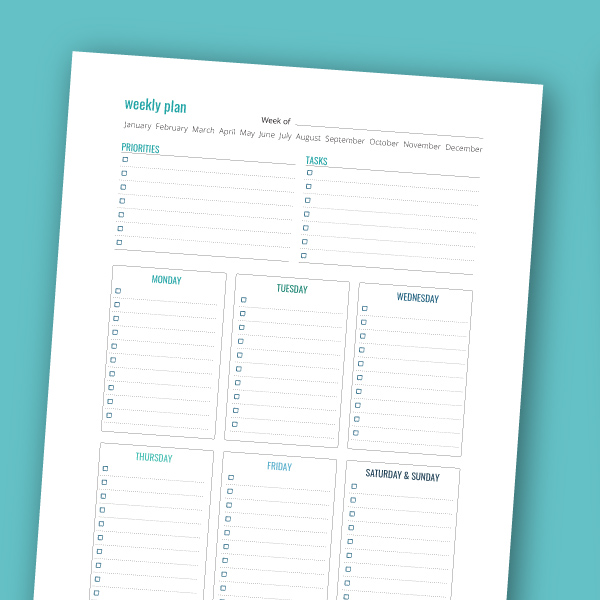
A spacious section for each day of the week, with customizable date entries. Accompanied by a task list, priorities, and a notes section.
Goal Tracker
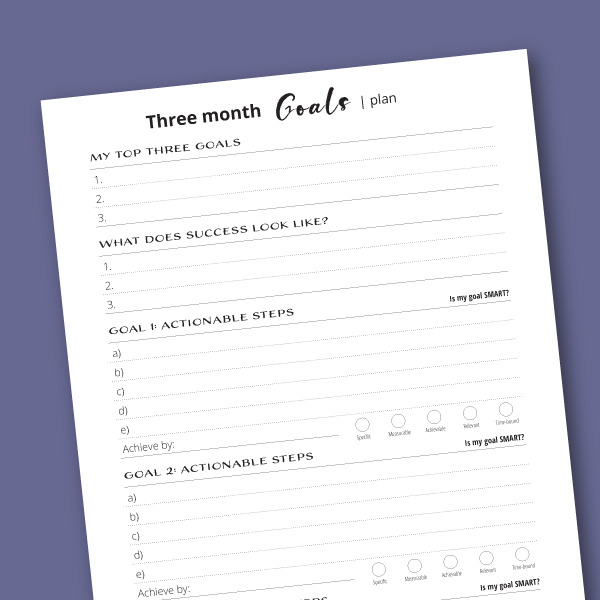
Set your short-term or long-term goals with progress trackers, motivational quotes, and reward ideas.
Monthly Calendar
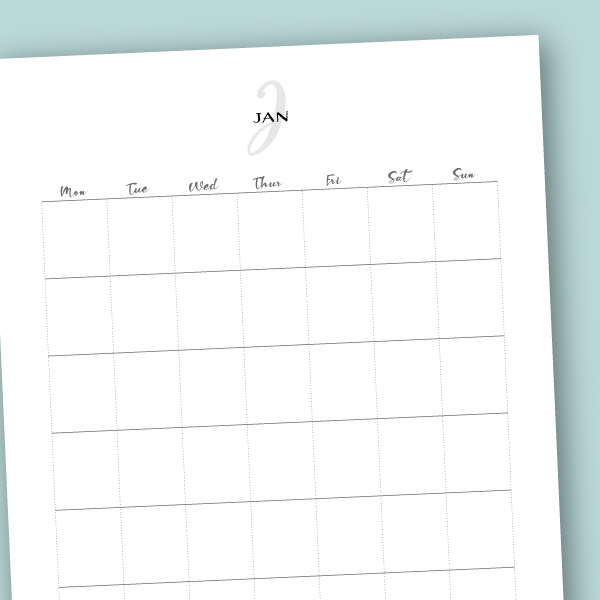
An overview of the month that adapts to your schedule. Add events, deadlines, and reminders at your convenience.
Top 8 Undated Planner Products: Your Path to Success
- Self Journal by BestSelf
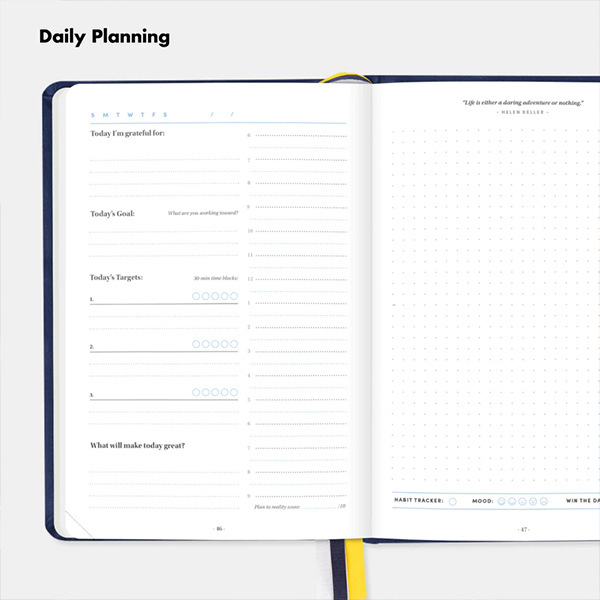
Undated 13-Week Planning, Productivity and Positivity System for Max Achievement and Goal Success — Track Gratitude, Habits and Goals Daily and Weekly
Image credit: Bestself.co
- The Full Focus Planner
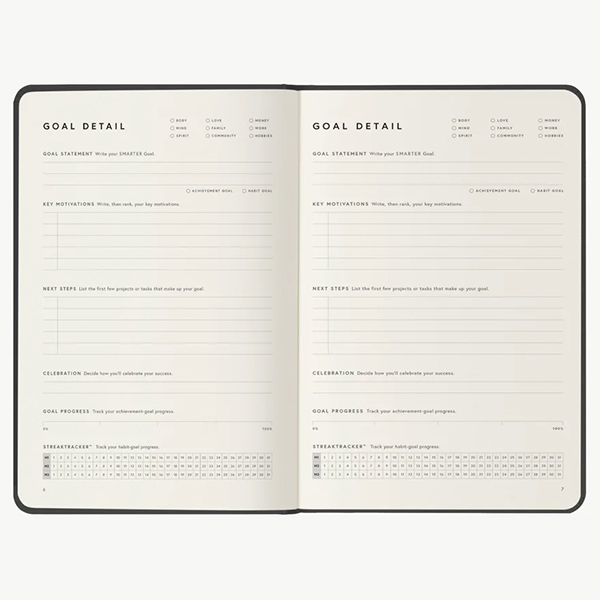
Three simple keys to reach your most ambitious goals & achieve the lifestyle you desire. The Full Focus System is all about working smarter, not harder.
Image Credit fullfocusstore.com
- Peak Productivity Planner
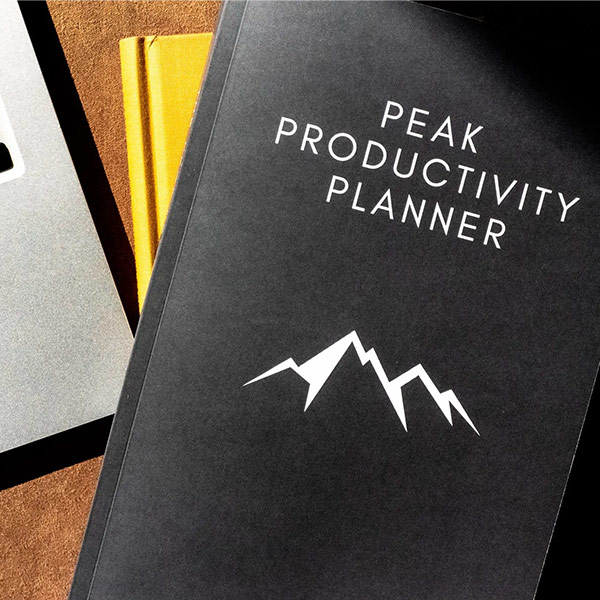
The Peak Productivity Planner is specifically designed to add more structure to your days and weeks, so you can get more done, stay focused on your priorities, and move closer to your long-term goals.
Image credit: personalgrowthlab.co
- Clever Fox Weekly Planner
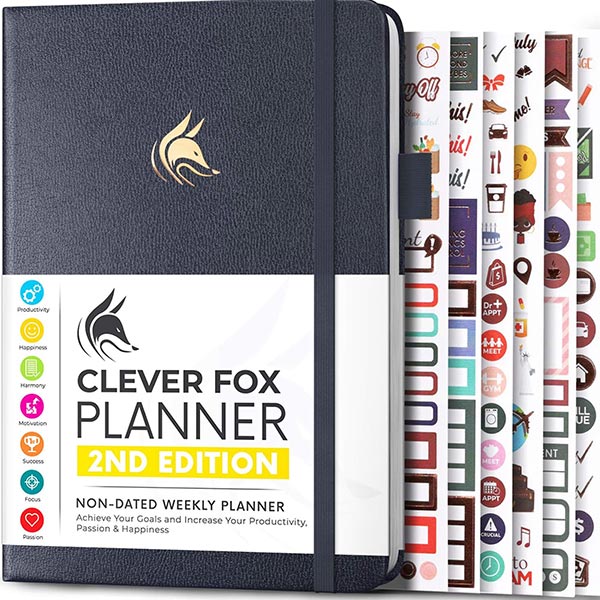
The Clever Fox Weekly Planner will help you create a vision for your life, define and break down your short and long-term goals in each area of your life, and incorporate these goals into your monthly, weekly, and daily agenda. Image credit: cleverfoxplanner.com
- Leuchtturm1917 Dotted Notebook
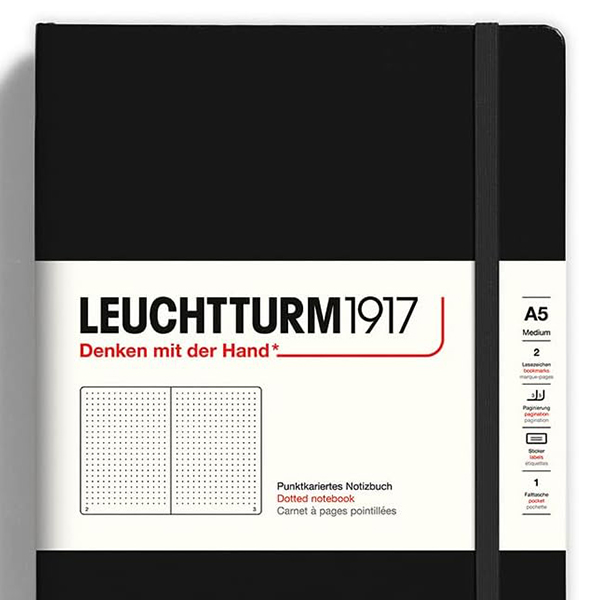
An absolute classic in the journaling and notebook world: The Leuchtturm1917 Hardcover Dotted Journal. Keep life straight with this medium-size organizer that opens flat and includes stickers for labeling. Numbered pages, dotted lines, a placekeeper, a blank table of contents, and an expandable inside pocket all help to keep to-do lists current.
Image credit: leuchtturm1917.ca
- Panda Planner Classic
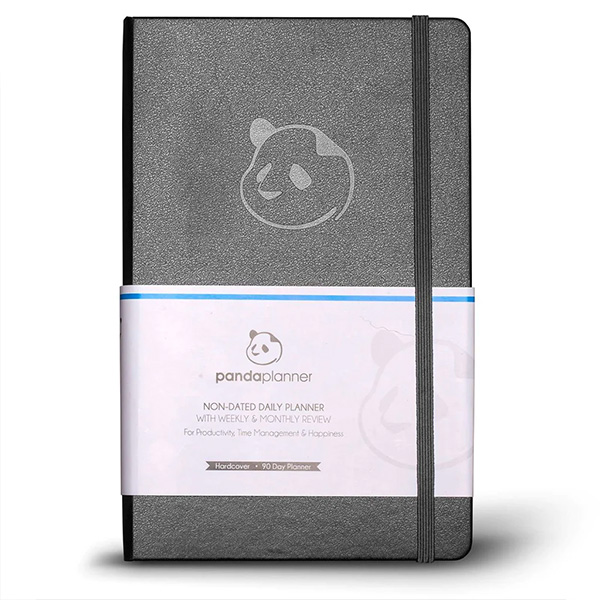
Panda Planner is a scientifically-designed daily planner that will empower you to take back control, reclaim your happiness and flourish in every way.
Image credit: pandaplanner.com
- The Three Month Planner

This highly customizable Three Month Planner helps you achieve your goals like never before. Set achievable goals and track your progress toward them with our disc-bound system, which allows you to add pages when and where you need them.
- Smart Planner Pro
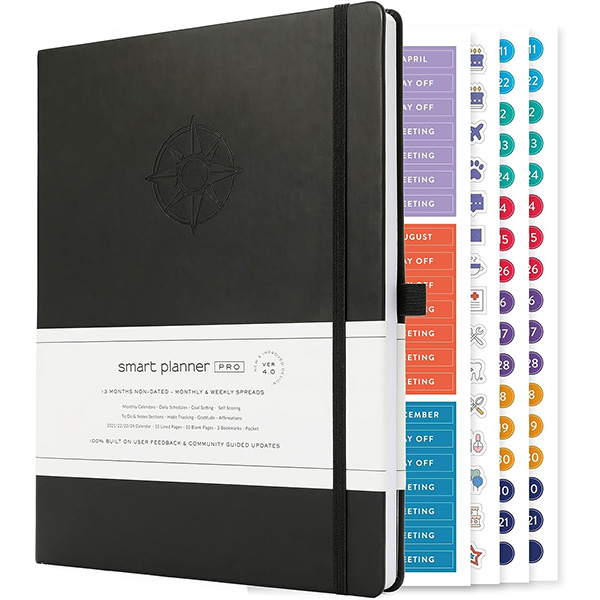
Meet Smart Planner Pro: a scientific approach to productivity and efficiency so that you can reach your highest potential! Space for gratitude, affirmations, notes, habit tracking and to-do lists – all of this without being too overwhelming.
Image credit: smartplanner.co
Printables: Tailoring Your Undated Planner to Perfection
Many undated planners offer printable templates for those who prefer a more customized touch. These can be especially useful for experimenting with layouts, trying new sections, or testing planning techniques before committing to a physical planner. Websites like Etsy offer a plethora of undated planner printables to suit your preferences, or check out West Coast Dreaming’s Minimalist Planner Kit to get you started.
The Symbiotic Relationship: Productivity, Goals, and Well-being
Undated planners are not just tools but allies in your journey toward self-improvement. By streamlining your tasks, aligning your actions with your objectives, and making time for self-care, these planners empower you to lead a fulfilling life. Remember, it’s not about the planner itself but the transformation it facilitates in your life.
In conclusion, the choice between dated and undated planners ultimately boils down to your unique preferences and goals. Undated planners offer the adaptability needed to accommodate life’s changes while fostering a sense of purpose and organization. They bridge the gap between productivity, goal achievement, and self-care, paving the way for a holistic and successful life journey.
So, if you’re ready to embark on a path of self-discovery, achievement, and well-being, consider embracing the undated planner revolution. Your future self will thank you for it.

by Nikola | Sep 14, 2023 | Achieve your goals, Happiness
Embarking on a personal development journey is like setting sail on uncharted waters, with the promise of self-discovery and growth on the horizon. It’s a quest that can lead us to unlock our true potential and live a more fulfilling life. However, the path to personal development can be complicated. People often find themselves stuck, hindered by obstacles that seem insurmountable. In this article, we’ll explore the three big steps in achieving personal development, why personal development is crucial, why people often encounter roadblocks, and, most importantly, how to overcome these challenges.
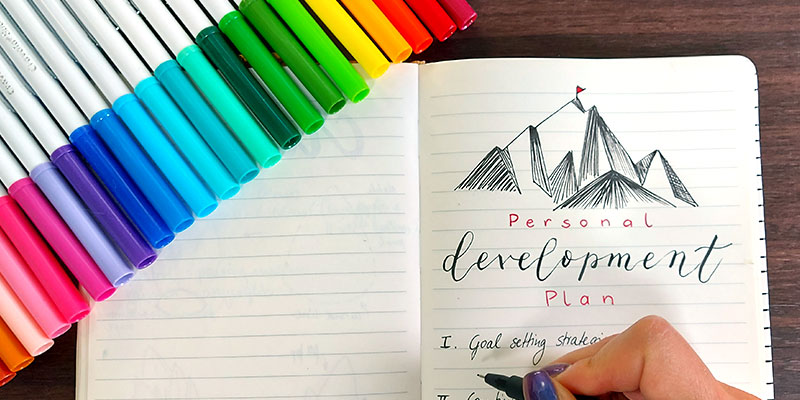
Why Personal Development Matters
Personal development is the ongoing process of improving oneself mentally, emotionally, and spiritually. It’s a conscious effort to become the best version of ourselves, allowing us to lead a more meaningful and purpose-driven life. But why does it matter? In a fast-paced world where change is constant, personal development equips us with the tools to adapt and thrive. It’s the key to cultivating self-awareness, enhancing our skills, and nurturing healthier relationships.
Getting Stuck: The Common Obstacles
While the desire for personal development is universal, many individuals find themselves stuck along the way. Common obstacles include fear of failure, lack of self-confidence, and the comfort zone’s allure. External factors like societal pressure and negative influences can also impede progress. It’s important to recognize that encountering these obstacles is a natural part of the journey, but overcoming them is where the true growth occurs.
The Three Big Steps: The Road to Transformation
To navigate the hurdles of personal development, one must adopt a resilient mindset and a willingness to confront challenges head-on. Here are three big steps in achieving personal development that can propel you forward on your personal development journey:
Step 1: Cultivate Goal Setting Strategies
Goal setting is the compass that guides your personal development journey. It’s about defining your aspirations and creating a roadmap to achieve them. Cultivating effective goal-setting strategies propels you forward with purpose and intention. Start by identifying your long-term vision and breaking it into smaller, actionable steps. This process clarifies your direction and provides a sense of accomplishment as you reach each milestone.
Read more
Tony Robbins’ RPM (Rapid Planning Method) is a powerful goal-setting framework that can help you clarify and achieve your objectives.
Step 2: Embrace Continuous Learning
Personal development thrives on a hunger for knowledge. Embrace a growth mindset that sees challenges as opportunities to learn. Acquiring new skills, whether relevant to your career or personal interests, expands your horizons and boosts confidence. Reading books, taking online courses, or attending workshops are fantastic ways to feed your curiosity.
Step 3: Take Action and Persist
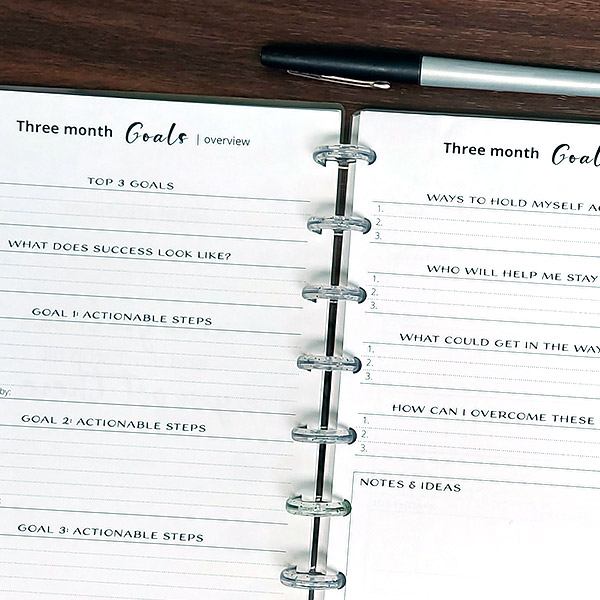
Turning intentions into actions is where transformation gains momentum. Break down your goals into manageable steps and take consistent action. Don’t be disheartened by setbacks; they’re part of the journey. Persistence is key. Surround yourself with a supportive community, be it friends, mentors, or online groups, to stay motivated and accountable.
Real-life Example
Read about Nick Vujicic and how his unwavering determination led him to achieve what seemed impossible despite having been born without arms or legs.
In pursuing personal development, you’re not just changing yourself – you’re evolving into the best version of yourself. The journey won’t always be smooth, but by cultivating self-awareness, embracing continuous learning, and taking persistent action, you’ll overcome obstacles and create a fulfilling and meaningful life. Remember, personal development is a lifelong adventure, and each step you take brings you closer to realizing your full potential. So, set sail with determination and embrace the transformation that awaits you. Your future self will thank you.

by Nikola | Sep 7, 2023 | Happiness, Achieve your goals
Searching for happiness is often entwined with pursuing success in a world driven by aspirations and ambitions. We all yearn for that perfect blend of accomplishment and contentment, where our achievements align seamlessly with our emotional well-being. But is there a science to this seemingly elusive harmony? Welcome to the realm of “The Science of Happiness: Achieving Success and Fulfillment on Your Journey.”

The Interplay Between Goals, Success, and Happiness
At the heart of the quest for happiness lies the intricate relationship between our goals, our success, and the joy we experience. Scientific research reveals that while success can contribute to happiness, the journey towards our goals holds equal, if not greater, significance. The anticipation, effort, and growth inherent in the pursuit contribute significantly to our overall well-being.
A study conducted by psychologist Daniel Kahneman found that people experienced more joy during the process of achieving a goal than upon actually attaining it. This phenomenon, known as the “progress principle,” underscores the importance of relishing the steps taken toward our dreams. Such findings encourage us to embrace the journey with open arms, savouring every challenge and triumph.
Read more
The below Harvard Business Review article delves deeper into the concept of the progress principle and how small wins contribute to happiness and engagement in various contexts, including work.
The Progress Principle: Using Small Wins to Ignite Joy, Engagement, and Creativity at Work
Cultivating Happiness While Chasing Dreams
Happiness is not a distant destination; it’s a state of being we can nurture even amidst the pursuit of our loftiest dreams. Positive psychology offers a wealth of insights into cultivating happiness along the journey.
- Practice Gratitude: Taking a moment each day to reflect on what we’re grateful for can significantly boost our happiness. A study published in the Journal of Positive Psychology showed gratitude, increased life satisfaction and a positive outlook.
- Foster Resilience: Challenges are inevitable on any path to success. Building resilience equips us with the ability to bounce back from setbacks. Researcher Carol Dweck’s work on a growth mindset highlights how viewing failures as growth opportunities can enhance our happiness.
Watch
In her TED Talk, psychologist Carol Dweck discusses the concept of a growth mindset and how it can impact our success, resilience, and overall happiness.
Carol Dweck: The Power of Believing That You Can Improve
- Prioritize Relationships: Human connections play a pivotal role in our happiness. Studies consistently show that strong social ties contribute to increased well-being. Cultivate and nurture your relationships as you work towards your goals.
Read more
Positive Psychology: An Introduction This comprehensive article provides an overview of positive psychology, including concepts like gratitude, resilience, and the power of relationships in contributing to overall well-being and happiness.
The Role of Organization and Progress Tracking
Staying organized and tracking progress might not seem directly related to happiness, but their impact is substantial. Clear organization minimizes stress and enhances focus, allowing you to immerse yourself fully in your journey. Similarly, tracking progress provides a sense of accomplishment and motivates you to keep moving forward. Check out these 80 Habit Tracker ideas.
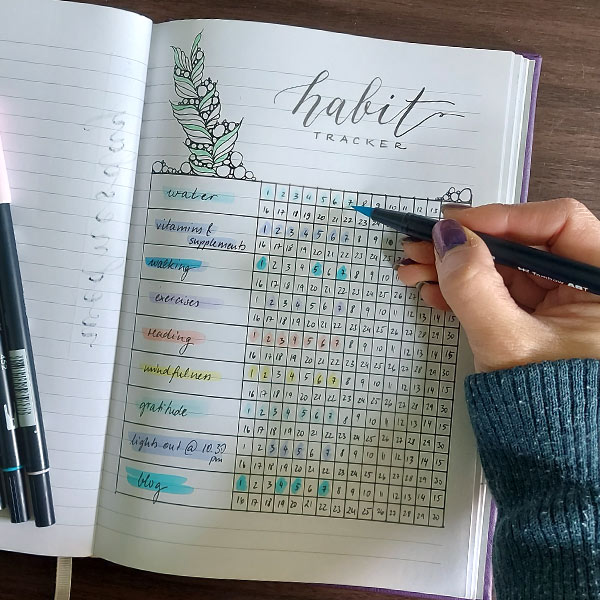
As you chase your dreams, remember that happiness is not a distant island; it’s a constant companion on your journey. The science of happiness unveils the significance of embracing the process, nurturing positivity, and staying organized. By acknowledging the progress principle, practicing gratitude, fostering resilience, and valuing relationships, you can chart a path that leads to success and fulfillment.
So, embark on your journey with a heart full of positivity and a mind attuned to the science of happiness. Your dreams await, and so does the happiness you deserve. Remember, your journey to success can be as fulfilling as the destination. Stay inspired, and keep chasing your dreams!
For those who would like to see and hear even more about the pursuit of happiness
Check out Gretchen Rubin’s Podcast: Happier with Gretchen Rubin. This “Happier” podcast offers practical tips and insights for living a happier life. Episodes cover topics such as habits, gratitude, and finding joy in everyday moments.
Dan Gilbert’s TED Talk The Surprising Science of Happiness explores happiness, discussing how our minds perceive happiness and how our “psychological immune system” can lead to contentment even in challenging circumstances.
Note: This article is intended to provide insights and suggestions based on scientific research. For tools and resources related to progress tracking and organization, explore options that suit your preferences and needs.

by Nikola | Jul 14, 2023 | An Organized Life, Bullet Journaling
We believe that dreams have the power to shape our lives and guide us toward success. However, turning dreams into reality requires more than just wishful thinking. It requires you to think strategically and commit to your goals. In this blog post, we’ll explore five effective goal-setting strategies to help you bridge the gap between your dreams and achievements. So, let’s dive in and start turning your dreams into reality!

Effective Goal-Setting Strategy Step 1
Clarity is Key
The first step toward achieving any goal is to gain clarity about what you truly want. Spend some time reflecting on your dreams and aspirations. Then, ask yourself: What do I truly want? Why do I want it? What does success mean to me? What specific goals will bring me closer to my vision? The more precise and detailed you are, the better. Remember, clarity sets the foundation for success.
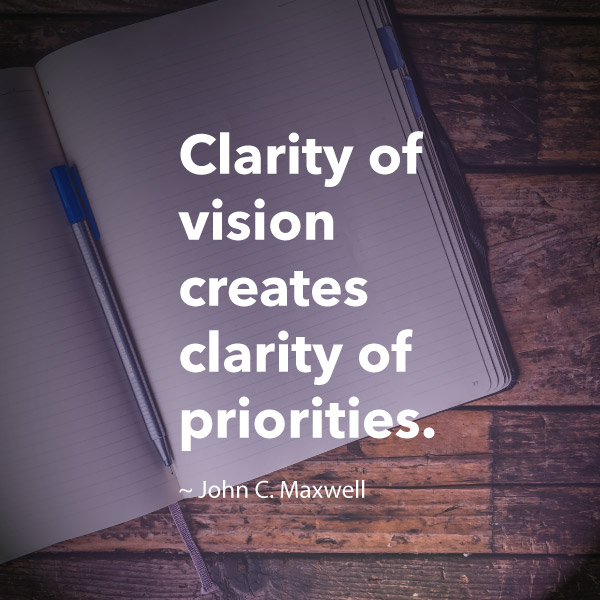
Effective Goal-Setting Strategy Step 2
Make your goals SMART
Once you clearly understand your goals, making them specific, measurable, achievable, relevant and timebound is essential. Instead of saying, “I want to be successful,” consider setting a goal like, “I want to increase my annual revenue by 20% in the next year.” Or redefine “I want to lose weight” to “I want to lose eight to ten pounds within the next two months.” By defining your goals in measurable terms, you provide yourself with a tangible target to work towards, making tracking your progress along the way easier. Check out this article if you want to learn more about SMART goals.
Effective Goal-Setting Strategy Step 3
Create Actionable Plans
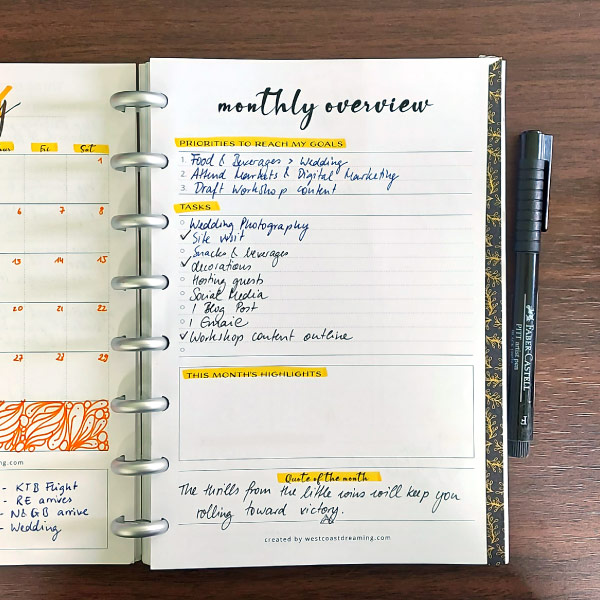
Setting goals without a plan is like setting sail without a map. So, after setting your goals and intentions, you need a plan that you can follow. To ensure success:
- Gather information and resources relevant to your goal. This could involve reading books, attending workshops, or conducting online research to gain knowledge and insights.
- Break down your goal into smaller, manageable and actionable steps. Define specific targets or achievements that will mark your progress along the way.
- Start by identifying the key milestones you need to reach and then outline the specific actions required to achieve each milestone.
Remember to set realistic deadlines for each step and hold yourself accountable.
Here is a sample to illustrate actionable steps (see #2) for the goal:
“I want to lose eight to ten pounds within the next two months.”
Break down your goal into smaller, manageable, and actionable steps:
- Consult a nutritionist to create a personalized meal plan based on your caloric needs and dietary preferences.
- Consult a fitness professional to design a workout plan that suits your fitness level and goals.
- Include cardiovascular exercises (such as brisk walking, jogging, or cycling) and strength training exercises (using weights or bodyweight exercises) in your routine.
- Aim for at least 15-20 minutes of your exercise routine daily, and increase your daily step level to a minimum of 8000 steps per day to boost your metabolism.
- Keep a food journal to record your meals, snacks, and portion sizes.
- Utilize a fitness tracking app or wearable device to monitor your exercise and track calories burned.
- Weigh yourself regularly (e.g., once a week) and take body measurements to gauge progress.
This approach will help you maintain focus and stay on track toward your ultimate objective.
Effective Goal-Setting Strategy Step 4
Consistent Progress is Crucial for Success
Consistency is the secret ingredient to success. It’s not about taking giant leaps overnight but making small, consistent strides toward your goals. Celebrate every milestone you achieve, no matter how small, and use that momentum to propel you forward. Remember, practice makes perfect and repeated action is progress, no matter how slow it may seem. Stay committed, stay motivated, and keep moving forward.
Pro-Tip
Consider using a habit tracker to make your progress visual and keep you motivated.
You can find inspiration in our post “80 Habit tracker ideas for your bullet journal“.
Effective Goal-Setting Strategy Step 5
Utilize Tools for Structure and Organization
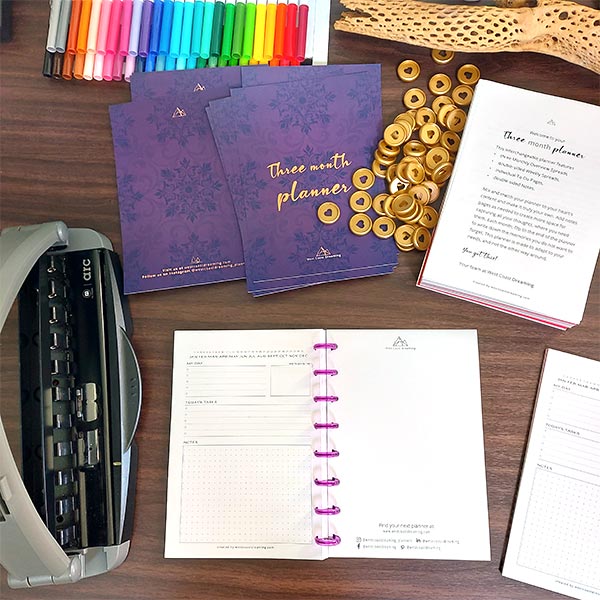
Goal setting can sometimes feel overwhelming, especially when you have multiple goals in different areas of your life. That’s where tools can be invaluable. Whether it’s a physical planner, a goal-tracking app, or a vision board, find a tool that resonates with you and helps structure and organization your goal-setting process. These tools will keep you focused, motivated, and on top of your game.
Summary
Turning your dreams into reality is within your reach. By following these five effective goal-setting strategies, you’ll gain clarity, set SMART goals, create actionable plans, maintain consistent progress, and utilize tools that provide structure and organization. As Bruce Lee once said, success is a journey, not a destination. Embrace the process, stay resilient, and let your dreams guide you toward the extraordinary life you deserve. Now, let’s start setting goals and making your dreams a reality!
Dream big, take action, and never stop believing in yourself.
Happy goal setting!
The West Coast Dreaming Team
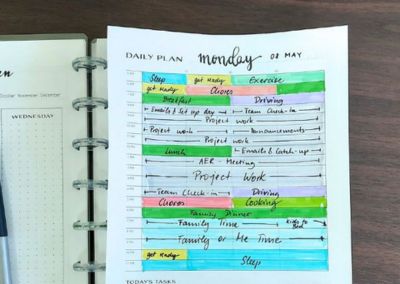
by Nikola | May 11, 2023 | An Organized Life, Bullet Journaling
Grab your free time-blocking e-book at the end of this post (includes printables!!). Click to take you there.
Time is our most precious resource, yet it often seems like there’s never enough of it. We’re constantly bombarded with distractions and interruptions that make it challenging to stay focused and get things done. That’s where time blocking comes in – it’s a powerful productivity technique that can help you take control of your time and use it more effectively. In this post, we’ll explore what time blocking is, how it works, and how to use it to achieve your goals and make the most of your time.

What is time blocking?
Time blocking is a technique that involves dividing your day into blocks of time and assigning specific tasks or activities to each block. By doing this, you can create a schedule tailored to your needs and priorities and ensure you’re using your time in the most productive way possible.
Why use time blocking?
There are many benefits to using this technique, including increased productivity, reduced stress, and improved work-life balance. Dividing your daily schedule into blocks of time can also help you prioritize your tasks, minimize distractions, and spend your time on the things that matter most to you.
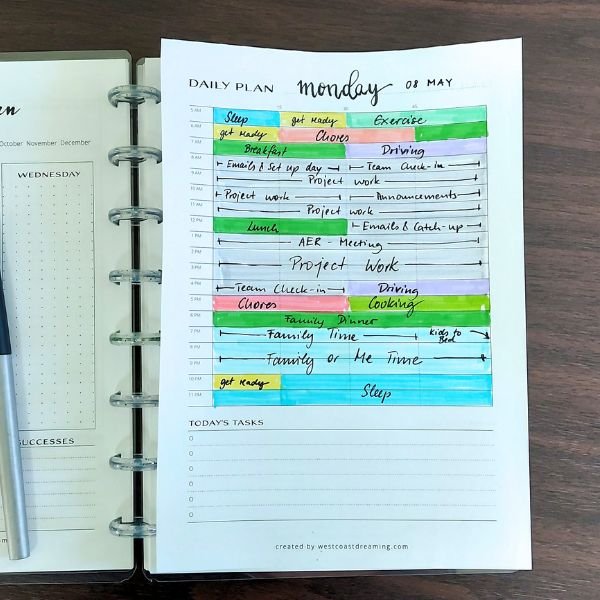
How to get started
Getting started is easy – all you need is a calendar or planner and a willingness to experiment and adjust your schedule as needed. If you want to make the most of your time, this method can be an incredibly effective strategy. First, set clear goals for yourself. This will give you a sense of direction and purpose and help you stay focused throughout the day. Next, identify your priorities so you know which tasks to tackle first. Finally, breaking your day into manageable time blocks of 15, 30 or 60 minutes can help you stay organized and on track. This allows you to work efficiently and avoid distractions, ultimately leading to greater productivity and success.
Tips for successful time blocking
While time blocking can be a powerful productivity tool, it does require some discipline and effort to make it work effectively. Effective time management requires setting achievable goals, being adaptable, and utilizing helpful software and tools to improve organizational skills. By implementing these key strategies, you can optimize your time management and quickly achieve your objectives. In addition, remember to prioritize tasks, take breaks when needed, and be flexible in adjusting your schedule. With these tips, you’ll be well on your way to mastering the art of time blocking and achieving success in your daily tasks.
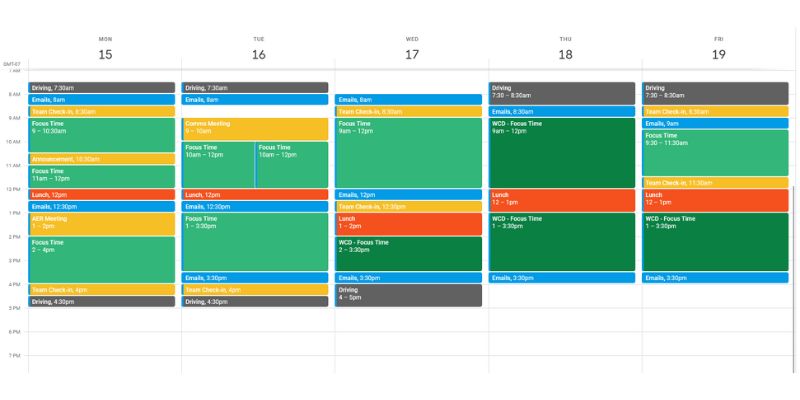
Common challenges and how to overcome them
Like any productivity technique, time blocking can have its challenges. Interruptions and distractions can quickly derail your schedule, making it difficult to stay on track. Be gentle with yourself, and remember to recognize that you are human and working on your goals and develop strategies to overcome your obstacles. One approach is scheduling time for interruptions and distractions, allowing you to address them without sacrificing productivity. Another method is eliminating or minimizing distractions by turning off notifications or finding a quiet workspace.
It is also common to underestimate the time it needs to complete a task. You’ll get better at estimating how long tasks take over time, but until you’ve honed your instincts, err on the side of blocking off too much time rather than too little. Instead, pad your schedule with extra time to complete and transition between tasks. You can even create “conditional blocks” of time you can tap into if you fall behind.
Try these tools
Find out how long it takes you to complete your tasks by tracking them with RescueTime or Toggl. Over time, this will improve your sense of much much time you should budget for in your daily or weekly plan.
By proactively addressing these challenges, you can maximize your time and stay focused on your goals.
Advanced time-blocking techniques
Once you’ve mastered the basics of time blocking, you can take your productivity to the next level. One such technique is “batching,” where you group similar tasks and complete them all at once. Another technique is “theme days,” where you assign specific themes to each day of the week and only work on tasks related to that theme on that day. These advanced techniques can help you stay focused and maximize your productivity, ultimately leading to greater success in both your personal and professional life.
Software and tools to improve your time-blocking skills
Various software and tools available can help with time blocking and organizational skills. One popular option is Trello, which allows users to create visual task boards and organize their to-do lists by priority and deadline. Another helpful tool is RescueTime, which tracks how much time you spend on various tasks and can help users identify areas where they may need to improve their time management. Additionally, apps like Focus@Will and Freedom can help eliminate distractions and enhance focus during designated time blocks. Ultimately, the best software and tools for time blocking will depend on individual preferences and needs, but these options are a great place to start.
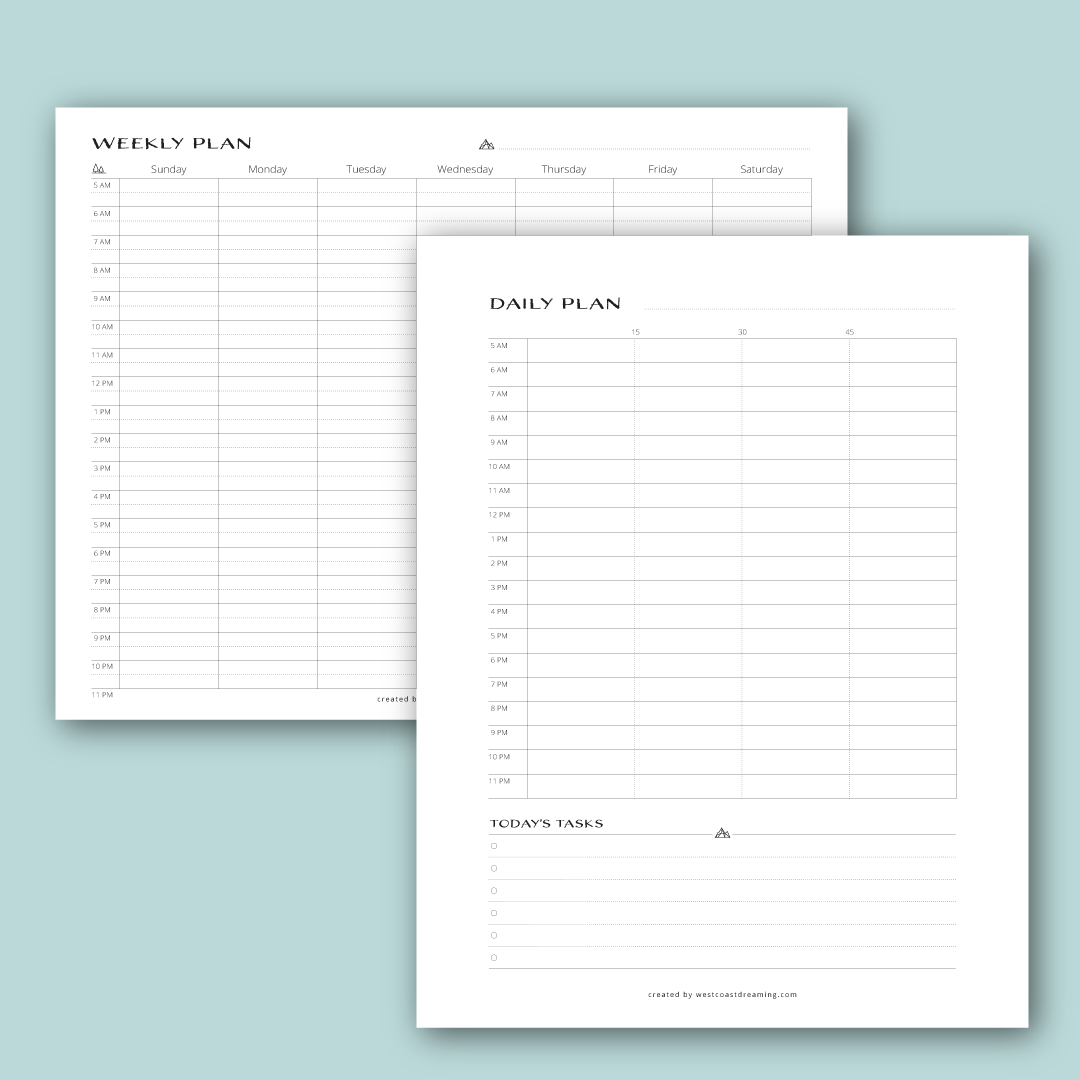
In addition to digital tools, planners and journals are popular choices for many people who prefer to have a physical record of their tasks and appointments. By writing down assignments and deadlines, users can better visualize their schedules and prioritize accordingly. Some people also find that physically writing down tasks can help them commit them to memory more effectively. Additionally, using coloured pens or stickers can help make the planner or journal more visually appealing and engaging. Ultimately, whether someone prefers digital or non-digital tools depends on their preferences and habits.
How long does it typically take to see the benefits?
The time it takes to see the benefits of time blocking can vary depending on several factors, including your current habits, the complexity of your tasks, and how effectively you implement the technique. However, with consistent practice and proper implementation, you can begin to experience the benefits of time blocking within a few weeks or even sooner. The process involves an initial adjustment period, followed by increased awareness and focus, improved productivity and time management, enhanced work-life balance and reduced stress. It’s important to note that individual experiences may vary, and consistency and perseverance are essential to fully realizing the benefits of time blocking.
Conclusion
Time blocking is a powerful tool that can help you take control of your time and achieve your goals. By following the tips and strategies outlined in this post, you can create a schedule that works for you and make the most of every minute of your day. So what are you waiting for? Start time blocking today and see the difference it can make in your life!
Free time-blocking e-book AND printables for you.

by Nikola | Apr 14, 2023 | Bullet Journaling
Whether you’re an artist, writer, or planner, having the right stationery, art and planner supplies can make a huge difference. Here are some of the reasons why you might want to invest in a selection of planner supplies, why we love stationery, and the best places to find all your stationery, planner supplies, and art supplies in Victoria, BC.
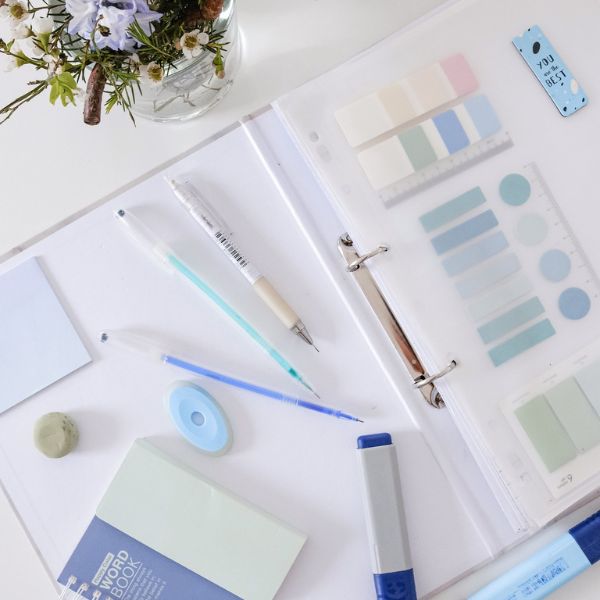
Do I need planner supplies to use my planner or journal effectively?
While it’s true that using a journal or planner can help you stay organized and on top of your tasks and goals, having the right supplies and stationery can make the experience even more enjoyable and effective.
If you are like me, you love a variety of writing materials, papers, pens, pencils, envelopes, stickers, washi tape, markers, and other related items.
Here are a few reasons why you might want to consider investing in more supplies and stationery for your journal or planner:
-
Customization: Having a variety of supplies, such as pens, stickers, and washi tape, allows you to customize your journal or planner to suit your style and preferences. This can make the experience more fun and engaging and help you stay motivated and committed to your goals.
-
Functionality: Using the right supplies, such as pens with different colours and tips, can help you organize your thoughts and tasks more effectively. For example, use a different colour for each category of tasks or a specific type of pen to prioritize your to-do list, tasks and appointments.
-
Inspiration: Using beautiful stationery and supplies can inspire your creativity and make journaling or planning feel more special. When you enjoy using your journal or planner, you’re more likely to stick with it and achieve your goals.
Of course, it’s okay not to have a ton of supplies and stationery at home to use a journal or planner effectively. However, having the right tools can make the experience more enjoyable, functional, and inspiring. So don’t be afraid to invest in a few extra supplies to enhance your journaling or planning experience.

Why many People Love Stationery and Planner Supplies
- It’s a form of self-expression: Stationery allows people to express their personality through their choice of paper, pens, and other writing tools. For example, some people prefer colourful or patterned paper, while others prefer sleek and simple designs. The choice of planner supplies reflects one’s individual style and taste.
- It’s a form of art: Many people enjoy creating art or calligraphy with their stationery. They may experiment with different types of pens, inks, and paper to create unique designs and lettering styles. In addition, creative processes can be therapeutic and relaxing for some people.
- It’s nostalgic: For some people, stationery brings back memories of a simpler time when letter writing was a more common form of communication. So writing a letter on beautiful stationery can evoke nostalgia and sentimentality.
- It’s a gift: Stationery can be a thoughtful gift for someone who enjoys writing, drawing, or organizing. In addition, it can be customized to suit the recipient’s tastes and preferences, making it a thoughtful and personal gift.
Where to buy stationery in Victoria?
Whether you are visiting or a local, and, depending on what you’re looking for, here are a few options in Victoria that suit your journal and planner needs.
- Monk Office & Art, formerly known as Island Blue Art & Framing: Monk Office & Art is a locally owned family business providing products and services to Vancouver Island’s creative and business communities and beyond. They offer a wide selection of art supplies, including paints, brushes, canvases, and more. They also have a great selection of stationery and planner supplies, including notebooks, journals, and pens.
- Opus Art Supplies: Opus Art Supplies is a chain of art supply stores with a location in Downtown Victoria. They offer a wide selection of art supplies, including paints, brushes, canvases, and more. They also have a great selection of stationery and planner supplies, including notebooks, journals, and pens.
- Munro’s Books: Munro’s Books is a locally owned and operated bookstore that has been a Victoria institution since 1963. They have a great selection of books, including art books and journals. They also carry a small selection of stationery and planner supplies, including notebooks and pens.
- Russell Books: Russell Books is another locally owned and operated bookstore in Victoria that has been around since 1991. They have a great selection of books, including art books and journals. They also carry a small selection of stationery and planner supplies, including notebooks and pens.
- The Papery: The Papery is a stationery store in downtown Victoria that offers a wide selection of stationery and planner supplies, including notebooks, journals, pens, and more. They also carry a small selection of art supplies, including pens and markers.
- Michael’s: Michael’s is a chain of craft stores with a location in Victoria in the Uptown Mall. They offer a wide selection of art supplies, including paints, brushes, canvases, and more. They also have a large selection of stationery and planner supplies, including notebooks, journals, and pens.
Whether you’re an artist, writer, or planner enthusiast, there are plenty of great reasons and places to find stationery and art supplies in Victoria, BC. From locally owned bookstores to chain craft stores, there’s something for everyone. So go out and find the perfect notebook, pen, or paintbrush to inspire your creativity and keep you organized. And if you haven’t seen our post on how to get started with a bullet journal, check out our How to Start a Bullet Journal post.
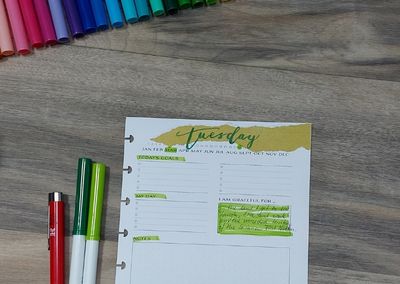
by Nikola | Mar 22, 2023 | Bullet Journaling
Planning your goals with a bullet journal or planner has become increasingly popular in recent years as a way to keep track of tasks, events, and notes in an organized and creative manner. However, even the most organized and careful journalers may need to correct mistakes from time to time. Errors can be frustrating to deal with, whether it’s a misspelled word or a misplaced line or point. But fear not! In this blog post, we’ll discuss some tips on how to fix mistakes in a bullet journal.
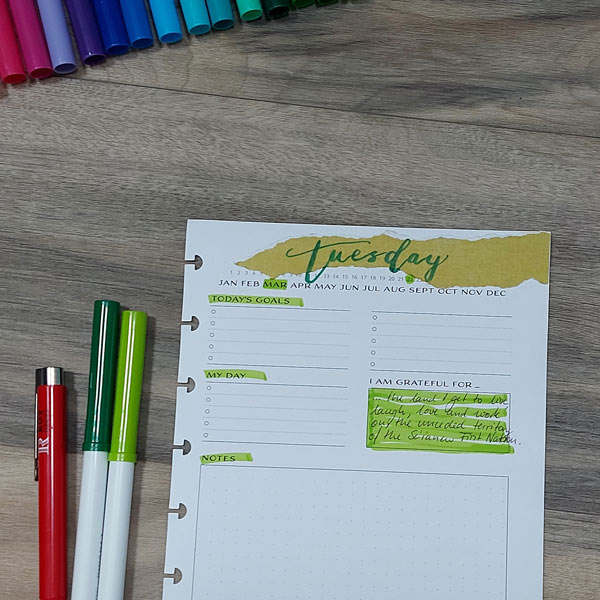
Tip #1: Cover Up – Use Craft Paper, Correction Tape or Whiteout
One of the simplest ways to fix a mistake in a bullet journal is to use correction tape, whiteout or a piece of paper. Cover Ups allow you to hide the mistake and try again. Grab a colourful piece of paper and get creative on your page. You can add even more of these pieces to give your page a distinctive look. These options are quick and easy, but keep in mind that they may leave a noticeable mark on the page.
Tip #2: Cross It Out and Rewrite
Another option is to cross out the mistake and rewrite the correct information next to it. This quick and easy fix doesn’t require additional materials, but it may not be the most aesthetically pleasing option.
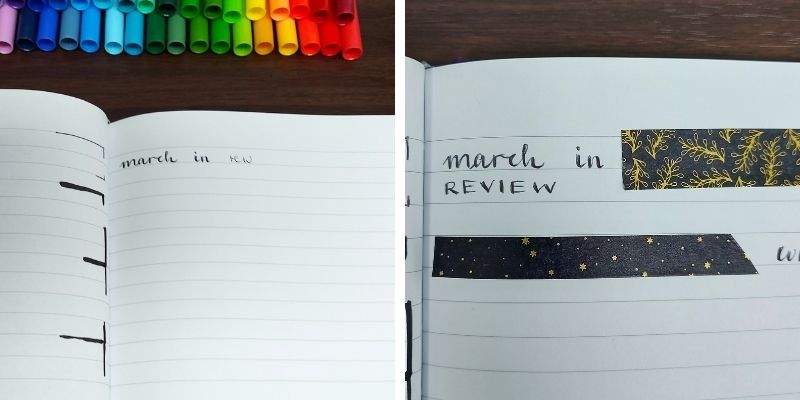
Tip #3: Use Washi Tape or Stickers
If you’re looking for a more creative way to fix a mistake in your bullet journal, consider using washi tape or stickers. Washi tape is a decorative tape that you can use to cover up blunders or add visual interest to your pages. You can also use stickers or add decorative elements to your bullet journal. This option is not only functional but also adds some personality and flair to your pages.

Tip #4: Add pages to your Bullet Journal
When you are creating your spreads ahead of time, your mind might wander from time to time. For example, after beautifully lettering the following weekday, you suddenly realize that you forgot a day in between. So simply add a page to your journal and get creative with the additional room you gained.
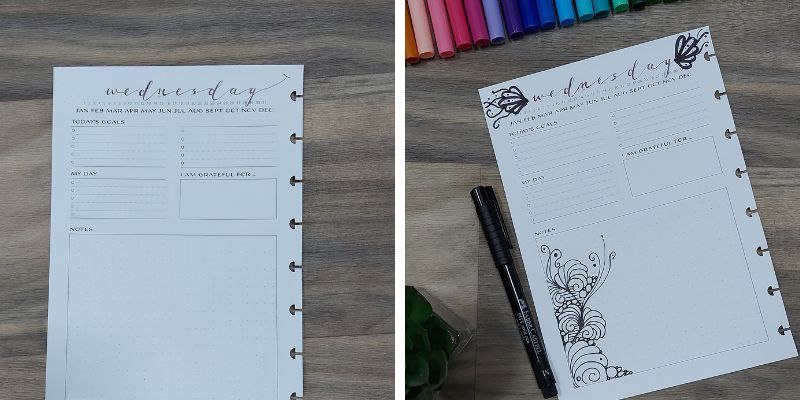
Tip #5: Make Something New
It can happen all too easily when drawing lines or planning on a nice flourish to end a word with, and the line goes not where it is intended to go. Embrace it and make something new. A favourite go-to is to doodle or to draw around it and incorporate the wayward line into an intricate new design element.
Tip #6: Embrace Imperfection
Finally, remember that mistakes are a natural part of the bullet journaling process, and it’s okay to have some imperfections in your planner or journal. You can even use mistakes as an opportunity to add some character to your pages. For example, you could doodle around a mistake or turn it into a funny anecdote. So don’t be too hard on yourself for making mistakes – embrace them and make the most of them!
In conclusion, fixing mistakes in a bullet journal is a simple process that can be done using a variety of techniques. Whether you prefer a quick fix or a more creative solution, plenty of options are available to help you fix mistakes in your bullet journal. Remember to embrace imperfection and enjoy the process of creating a personalized and unique journal that reflects your personality and interests.
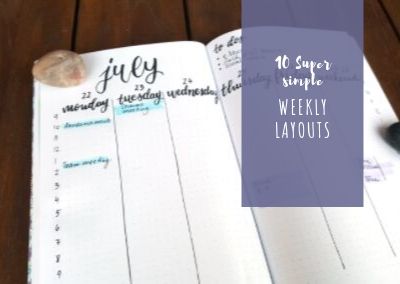
by Nikola | Jul 17, 2019 | Bullet Journaling
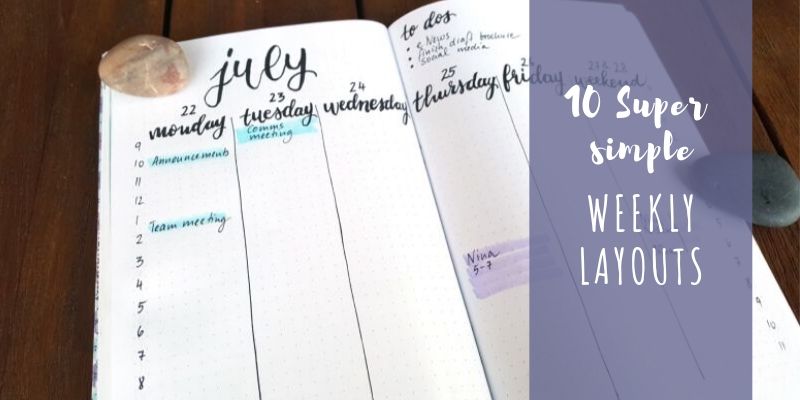
A good weekly spread is the backbone of your bullet journal and will probably either make or break the habit. If you find them too complicated or tedious, it will be hard to keep at it. If you are not happy with the way they look or how creative you can get or the space you have to express your thoughts, you might get discouraged and not stick to your new ritual. . How to get it right? Well, find a set of layouts that you like and understand your needs and goals. Are you a minimalist, the creative type, do you delve in watercolour, or do you want to explore them all? Check out these 10 super simple weekly layouts for your bullet journal and decide for yourself what suits your needs best.
Horizontal
In my experience, I have found the horizontal spreads to be the best if you prefer to jot down memories. The horizontal format gives you the space to write short sentences or bullets, and, depending on the size of your journal and handwriting, leave room for creative space.
In the next four spreads, you will see the same theme in four different varieties. Same basic layout, four entirely different looks.
The minimalist
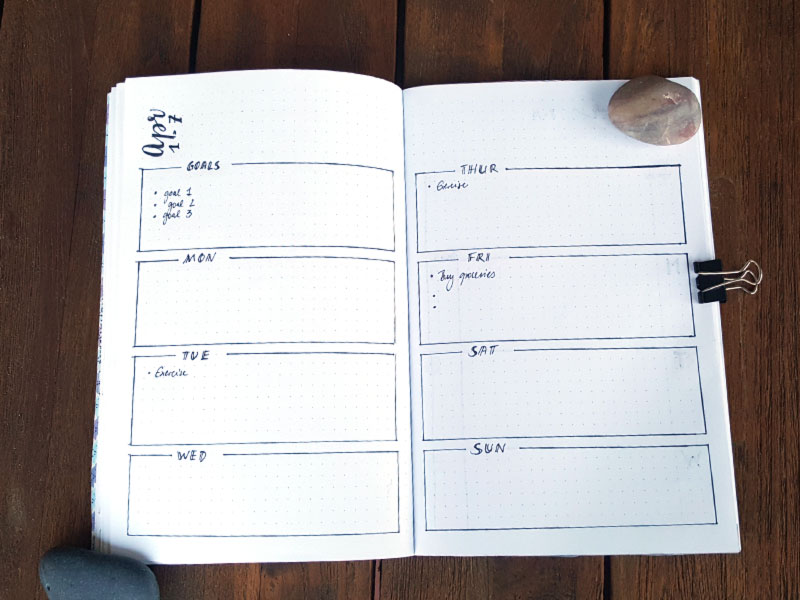
Boxes denote the space for your weekly goals and each day. Instead of boxes, you can choose lines, or separate the daily space with the day of the week in your favourite brush lettering font.
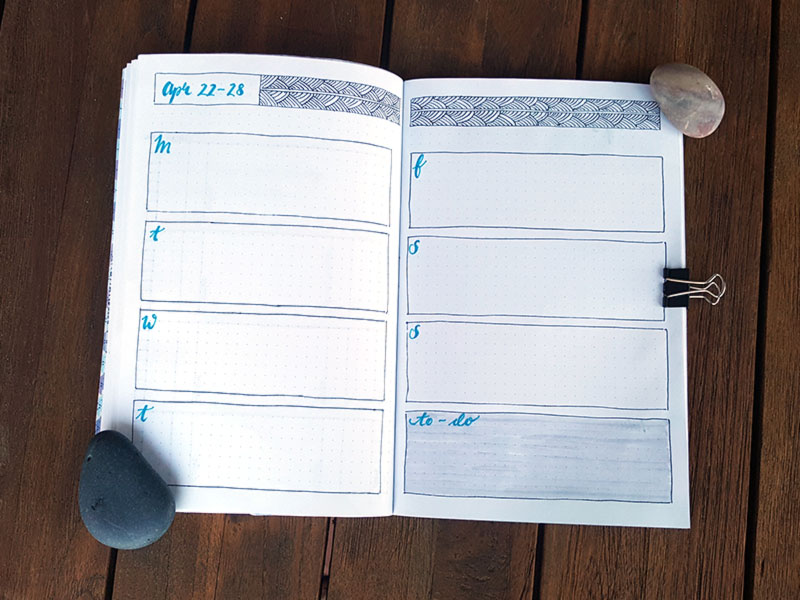
You could try the same format, boxes and all and add some tangle patterns as a design element? Doesn’t take long and creates a distinct look for that particular week. Find the instructions to this pattern in my tangle pattern post.
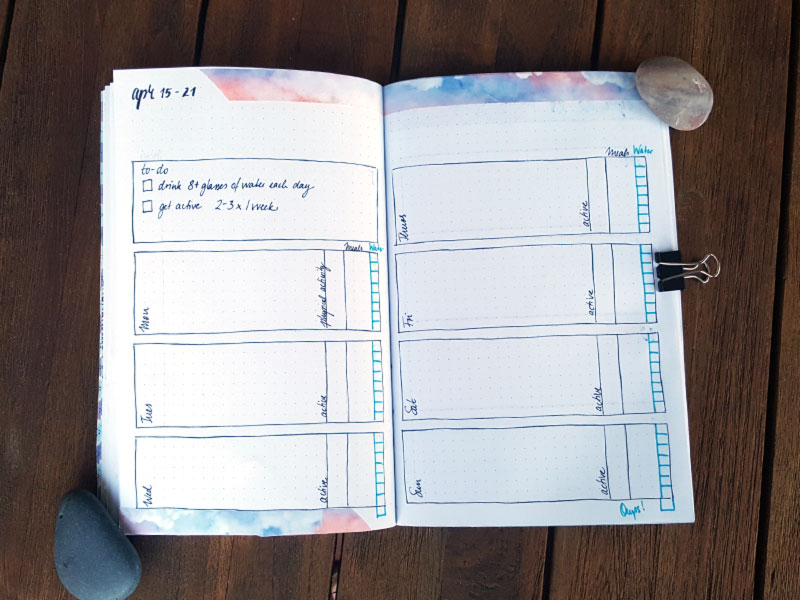
Again, I used the same format again, this time added some fancy washi tape and created room to track water intake, meals and active time.
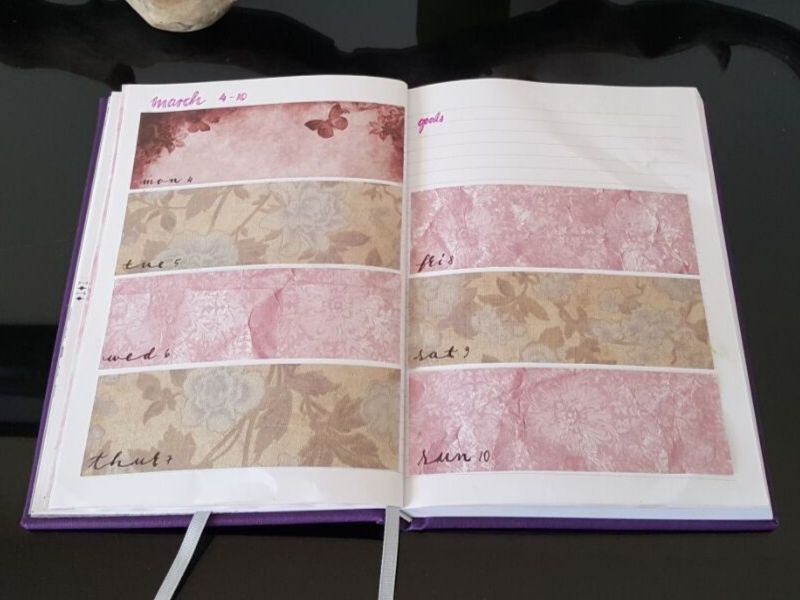
If you have some lightly coloured craft paper, you can also use this to create a stunning spread using the same structure.
How to deal with the tail end of the month?
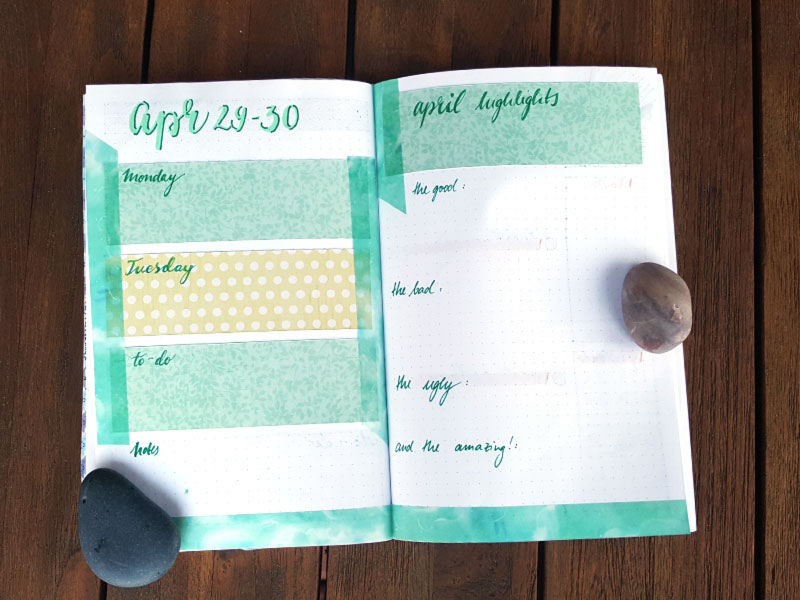
What to do with the end of the month? How do deal with the gaping white space that needs to be filled? First of all, don’t panic. As I learned in design school “Don’t be afraid of white space. The page elements need this space to breathe.” Secondly, I started to use the extra space for either some creative outlet or a mini reflection on the month. This will help you greatly when you do your year-end reflection. The more you make yourself aware of what happened each month, the less often you look back at the past year not remembering how it went by so fast. No more blank spots and more memories which all in all help you perceive time to progress a little slower.
Weekly spread with habit trackers
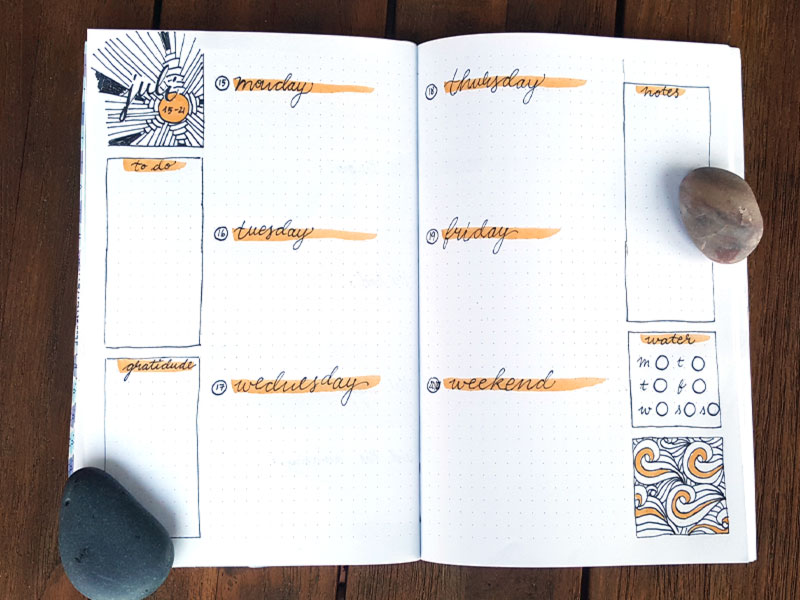
Ok, we have finally left the same-old horizontal pattern behind and added creative and tracking spaces to the sides.
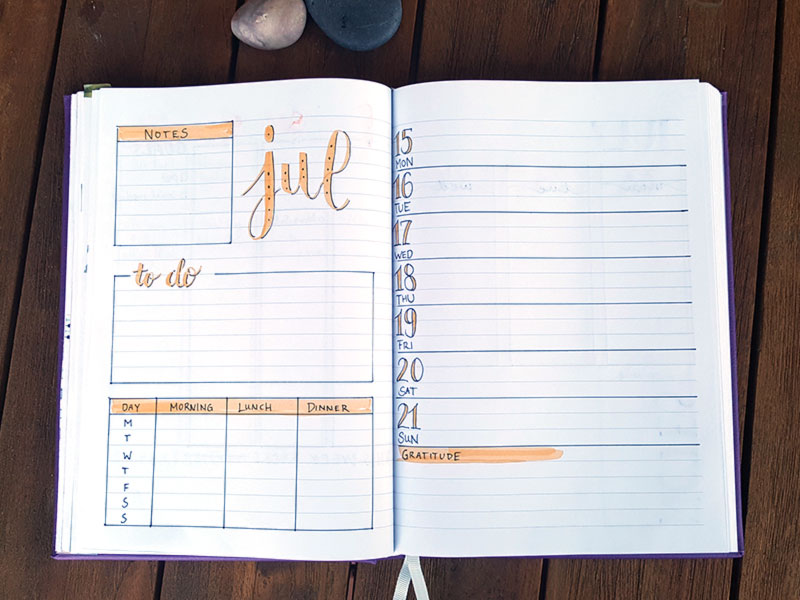
This is a weekly spread one-pager that tags on a page with goals, trackers or whatever you want to add to your page. Not to forget space to give gratitude, my favourite tool to staying mindful, and appreciative of the blessings in my life.
Vertical weekly layouts for your journal
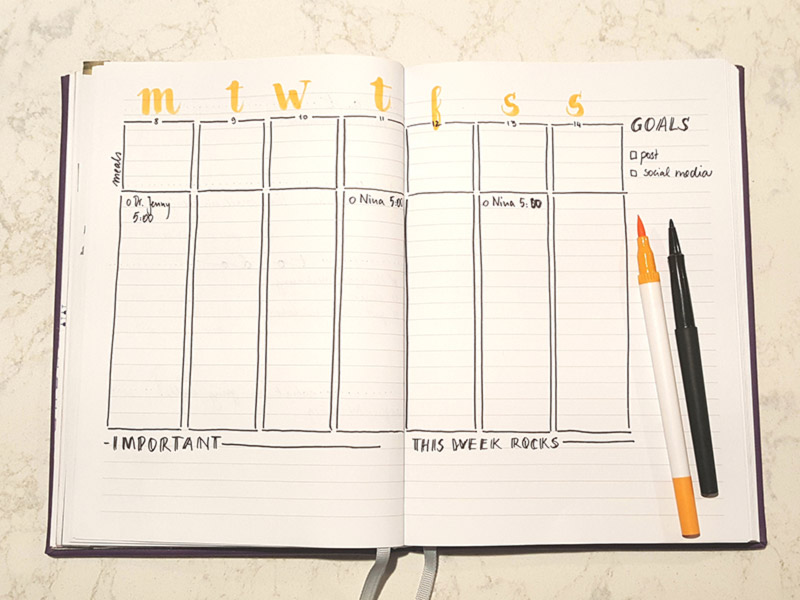
The vertical layout is ideal if you want to highlight your appointments, and jot down simple notes. It is the perfect way to gain an overview of your week.
In the simple weekly layout above I decided to hand-draw my lines, which give the page a distinct freestyle look. See the spread below that features accurate boxes which I drew using a ruler.
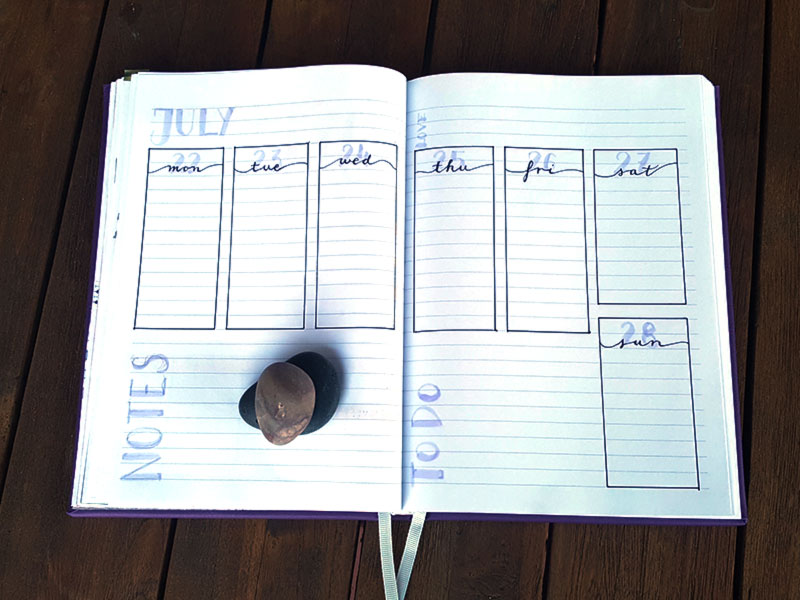
This layout provides lots of space for notes or trackers while clearly structuring your week. I love the simplicity and contrasting beauty of the black cursive versus rigid grey lettering.
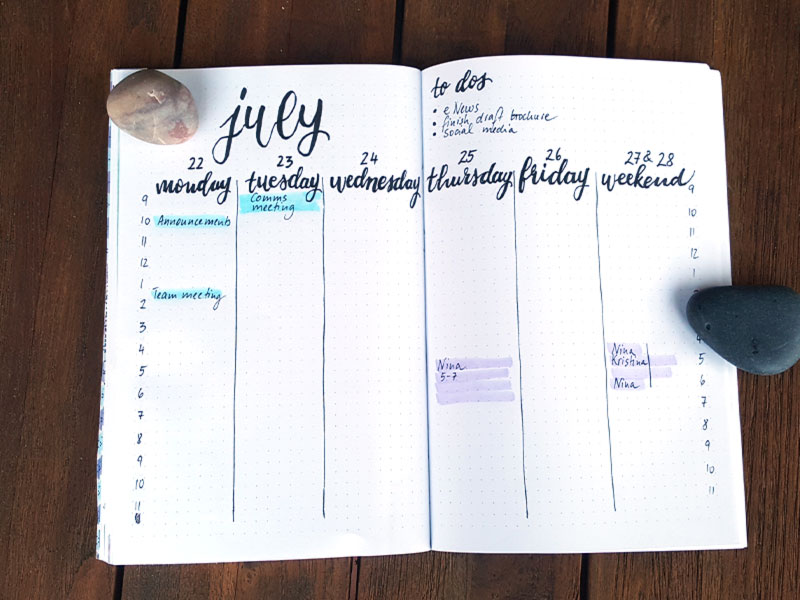
This layout focuses on giving you an hourly overview of your day. It could also be used to track how you spend your time and see where there are “pockets” of time that you could use more efficiently.
Whether you are a seasoned bullet journaler and already have your favourites, or are are about to find your style, it is always fun to try out something you don’t usually do. What I love about journaling is that I can fit it exactly to my needs. If I am feeling minimalistic, i’ll go after that style. If I need to focus on tracking anything, in my case usually water intake, goals, gratitude and exercise, I can do that. Care to share which weekly layout you prefer for your bujo?
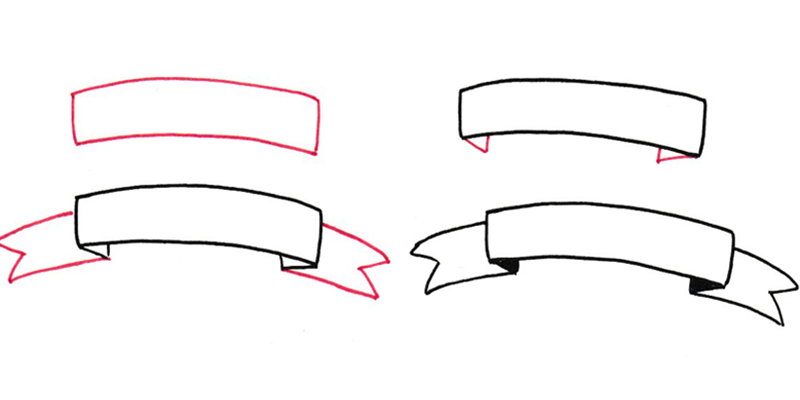
by Nikola | May 20, 2019 | Bullet Journaling

Have you ever wondered how so many bullet journals are lovingly adorned with beautiful banners and why they look always crooked when you try to do draw them? This is totally me. And that is exactly why I am writing this post today: to help you hoist your banners and let them fly high all across your bullet journal. And without further ado, here is how to draw banners. Five different ones to be exact.
Why do we like banners? They help you structure a page or give emphasis to a headline. They are eye-catching and all in all so much fun to draw.
1. The Classic
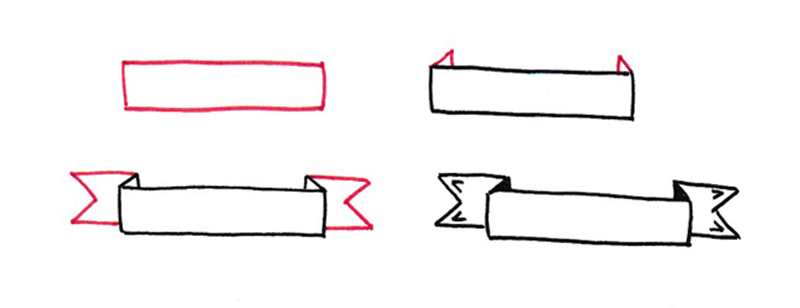
Start with a rectangular box. Then add two small triangles to the top. Now add the flaps. Make sure the flaps end higher than your box’ baseline. If you want you can now add texture to the flaps and darken the triangles (back of the flap).
2. The Classic – variation

As the title suggests, this is a variation of the first banner I showed you. With this one, I chose to curve the base box ever so slightly. Follow the steps as prompted and you can’t go wrong.
3. The Wrap
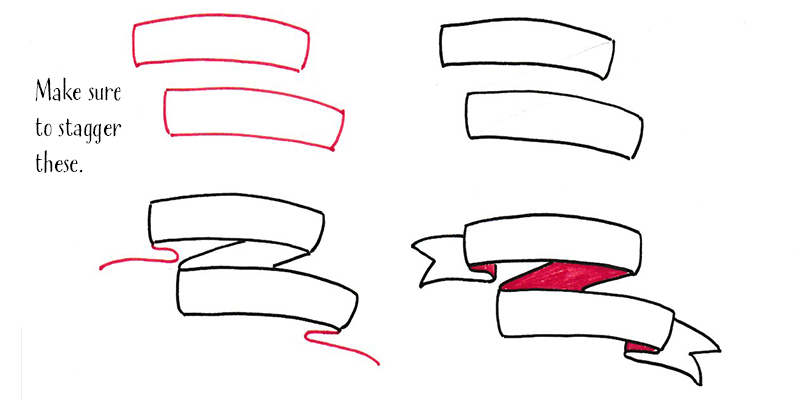
This one is a little bit more advanced, but you can do it. I had to fiddle around with it at first, but it did turn out nicely. Make sure to stagger your first two boxes. Then, connect them in a Z like way from the end of the top to the beginning of the first. The flaps are similar like the ones above but achieved differently. The bottom lines almost look like a swoosh.
4. The Single Fold
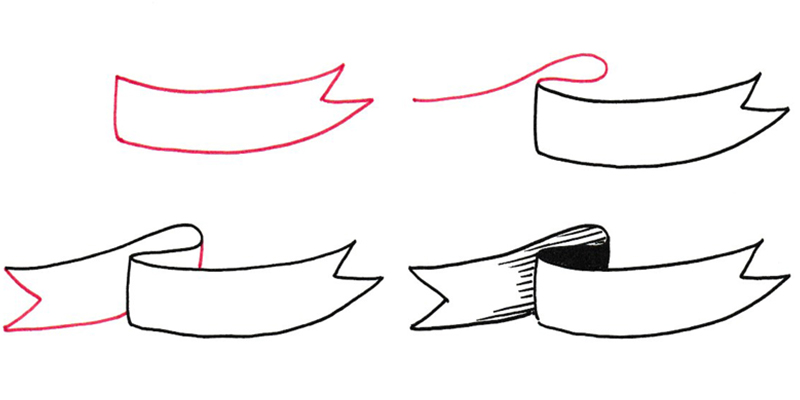
Start the single fold with a slight bend to your base box. You can let this end in a forked flap if you wish. Next, add your upper swoosh (would also work on the bottom). Finish your
5. The Scroll
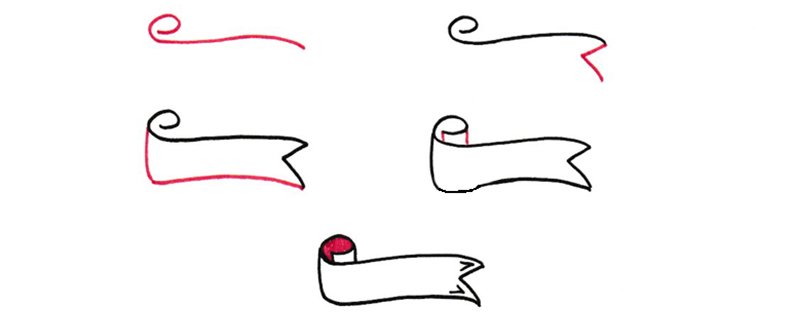
Start your top line almost like a lower-case letter e with a very long tail. Then add your vertical V-shape to create the side of the flap and close up your base box. Make sure the lower curve of the box matches as closely as you can to your upper curve. Add two vertical lines to finish off the scroll look and et voila, you did it.
A few more tips: Test your headline size and length before you set your banner in stone, so to speak. Penciling in the headline and box size helps a great deal. You can also create your favourite banners on one sheet, and draw them in a nice “fat” black. Keep this sheet handy and you can use this to trace your next banner into your journal or similar medium. Never forget, have lots of fun and keep practicing how to draw banners. It’ll become second nature in no time.
Have fun practicing how to draw banners.

by Nikola | Apr 24, 2019 | Achieve your goals

If you were ever overwhelmed by life and the goals you put on your agenda, you probably know how hard it is to get back on track. You might feel like hiding, procrastinating or not being able to stop worrying about many things in your life. And all these feelings usually come with a huge amount of guilt. Guilt for feeling overwhelmed in the first place, for not being able to progress, for being not strong enough.
Let me tell you bluntly, this is a lot of bull**** your subconscious is trying to feed you. Stop buying into the guilt trip right now. It is ok if you still feel it, but don’t feed it anymore, just let it all go, slowly but surely. I am telling you this so drastically because I have been there so many times. In fact, I am making my way just out of this guilt-bull**** right now.
“You can’t crush your goals if you are running on empty.”
I got overwhelmed by my own plans and goals, took some self-prescribed time off my blog, and wallowed in guilt over not being able to get back on track with my goals. After about 2-3 months of a complete stop, I am just starting to feel better and getting back to writing, to thinking creatively and being excited about it all.
So, how can you get there? Here are my 8 tips on how to get back on track with your goals:
1. Assess what stage you are in

To know what stage you are in, will help you determine the next steps to take.
For example, if you are in the overwhelmed phase, it would be next to impossible to jump right to taking the first steps in the right direction again. You first have to take very good care of yourself.
The process might look like this:
-
Stressed
You realize that there is a lot on your plate, but you want to push forward on your goals, so you just keep going. Probably, you don’t know how to scale down and simply hope it will get better on its own. Trust me, it never does get better on its own. You need to make it better. And you can do it.
-
Overwhelmed
This is the head-in-the-sand feeling, where all of a sudden even enjoyable activities like hanging out with friends or taking time for yourself will stress you out. You might come to a halt and stop as many stressors as possible. Work, health, and family-related stressors are usually much harder to put on hold and might need an entirely different approach.
In all honesty, I can say that I am not able to look at any of these tips in any stage before ‘rebound’. Self-care and feeling better must come first.
2. Go back to your why
Why did you set your goal in the first place? Every good goal starts with why. Go back and try to find it. Tell yourself or write down why you decided to take on this goal in the first place.
A few days ago, a co-worker asked me about my blog. I sighed and told her how I put it on hiatus because I was overwhelmed. As I described the entire situation to her and explained the purpose of this blog, I reminded myself why I started this in the first place. Inspiring people to follow their dreams and live their lives passionately is what this site is all about. Et voilà, I am currently working on this article and taking the first step back. Whatever your goal is or was, dig deep and find your WHY. The more you can tie it to a positive emotion, the easier it will be for you to get back on track.
3. Assess your goal(s)
Take a good look at your goals for the year. Go through them one by one, prioritize again and throw overboard what no longer suits you. What is your most important item? Put this on top of your list. Goals can change. That’s ok.
4. Are you still passionate about your goal?

Let’s talk about the one goal you have gotten off track with. How much do you still want it? Very much? Is it worth fighting for? If deep down, you don’t really care about your goal it will be infinitely harder to get back and stay on track.
5. Acknowledge and let go
Acknowledging what is happening and being ok with it is an important step to make when you want to get back on track. Try to write down your own acknowledgment sentence:
“I have gotten off track with ______________ because ________________________. I need to _________________. I will not beat myself up about it anymore. It is ok to get overwhelmed and it is even better to take care of myself. I am still passionate about ________________ and want it to succeed. I can do it!”
Wow, this felt good, hey?
Here is mine: “I have gotten off track with blogging because I was overwhelmed by work and all that needed to be done to kick-start this blog. Stopping everything and getting better first is my first priority. I will not beat myself up about it anymore. It is ok to get overwhelmed and it is even better to take care of myself. I am still passionate about my blog and want it to succeed. Everything I want to achieve, I can achieve.”
6. What is holding you back?
When you think about getting back on track, what does this look and feel like? Are you feeling overwhelmed just thinking about it? Do you feel you don’t know where to start again or are you afraid that you can’t do it? Write down all your perceived and real obstacles and ideas on how to overcome them and then move on to the next point.
7. Create a new action plan

Now that you have reconfirmed your goals and acknowledged your obstacles, it is time to set a new action plan and schedule. Start small. Don’t overwhelm yourself again. Include enough self-care in your plan and remember that a schedule is not a deadline. You want to enjoy this.
8. Put your plan into action

Just get started, it doesn’t have to be perfect. After all
your careful planning, you can’t go wrong. Start small and start somewhere. If you need a day off tomorrow, that is ok. If you keep thinking about it, that is excellent. It means you are excited about your goal and that will help you get back on track. Take your time.
No matter where in the process you are, you deserve a big pat on your back. Just the fact that you are thinking about this, means you are on the way to getting better and getting back on track. You have not abandoned your goal, but rather care about it so much that you researched on how to get back on track. Hold on to this. It will serve you well and get you far. This all takes time, patience and persistence. Be good to yourself.
If you are a journaler, track your progress in your (bullet) journal. I am not kidding, this makes you realize that you are making progress. It is very powerful. Because after all, happiness is perceived progress.
Throughout my journey of recent overwhelm and resulting self-care, I came across this quote, that has helped me to make it through and helped me get back on track:
Be stubborn about your goals, but flexible about your methods. Namaste.




























































